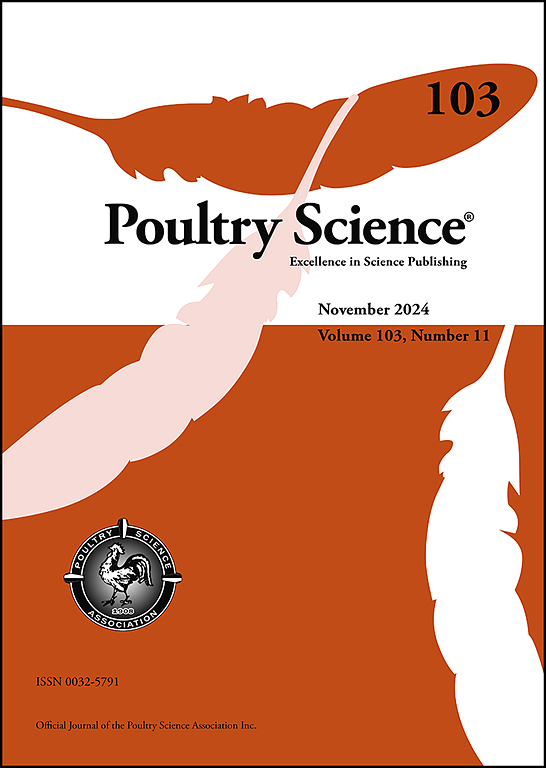Effectiveness of sanitizers on different biofilm-forming microorganisms associated with the poultry drinking water system
IF 3.8
1区 农林科学
Q1 AGRICULTURE, DAIRY & ANIMAL SCIENCE
引用次数: 0
Abstract
The sanitation of the poultry drinking water system (DWS) is essential to controlling pathogens and biofilms in the DWS. Intervention approaches including several sanitizers have been developed, but there is limited information on the efficacy of some of these sanitizers. The aim of this study was to evaluate the effectiveness of peracid-based (PAB), peroxide-based (PB), and hypochlorite-based (HB) sanitizers against field-isolated Salmonella (10), E. coli (2) and Bacillus (2), along with their antibiofilm effects on six of these bacterial strains on polyvinylchloride (PVC), a common DWS pipe material. The minimum inhibitory and bactericidal concentrations (MIC and MBC) were determined using the microdilution broth method. For biofilm production, PVC rings were inoculated (5-6 Log10 CFU/mL) in buffered peptone water, incubated at 30°C for 48 h, and detached with cotton swabs for quantification. The antibiofilm effect of the sanitizers was further assessed at MIC, 2X-MIC, 4X-MIC, and water (control). Data was analyzed using ANOVA and Least squares in JMP Pro 18. The MIC and MBC of PAB for all isolates ranged from 11.36 to 28.42 ppm, PB from 15.26 to 71.21 ppm, and HB was 106.67 to 350 ppm. Bacillus licheniformis formed the most biofilm (5.39 Log10 CFU/mL) as single-species bacteria while Salmonella attached more (6.36 Log10 CFU/mL) than E. coli (5.41 Log10 CFU/mL) and Bacillus (2.08 Log10 CFU/mL) when grown together in mixed cultures. PAB and HB eliminated the biofilms of all strains tested at MIC in mixed-species cultures while PB had no significant effect. Overall, PAB demonstrated the greatest potential as a DWS sanitizer, showing superior efficacy against planktonic and biofilm cells compared to PB and HB. This research highlights the importance of targeted microbial profiling and sanitizer efficacy testing for pre-harvest pathogen control, providing valuable insights for enhancing food safety in poultry production systems.
杀菌剂对与家禽饮用水系统相关的不同生物膜形成微生物的有效性
家禽饮用水系统(DWS)的卫生对于控制 DWS 中的病原体和生物膜至关重要。目前已开发出包括几种消毒剂在内的干预方法,但有关其中一些消毒剂功效的信息还很有限。本研究的目的是评估过酸性消毒剂 (PAB)、过氧化物消毒剂 (PB) 和次氯酸盐消毒剂 (HB) 对现场分离的沙门氏菌 (10)、大肠杆菌 (2) 和芽孢杆菌 (2) 的有效性,以及它们对聚氯乙烯 (PVC) (一种常见的 DWS 管道材料)上六种细菌菌株的抗生物膜效果。采用微量稀释肉汤法测定了最低抑菌浓度和杀菌浓度(MIC 和 MBC)。对于生物膜的生成,将 PVC 环接种到缓冲蛋白胨水中(5-6 Log10 CFU/mL),在 30°C 下培养 48 小时,然后用棉签将其剥离以进行定量。在 MIC、2X-MIC、4X-MIC 和水(对照)条件下,进一步评估消毒剂的抗生物膜效果。数据使用 JMP Pro 18 中的方差分析和最小二乘法进行分析。所有分离菌株的 PAB MIC 和 MBC 为 11.36 至 28.42 ppm,PB 为 15.26 至 71.21 ppm,HB 为 106.67 至 350 ppm。地衣芽孢杆菌作为单一菌种形成的生物膜最多(5.39 Log10 CFU/mL),而当沙门氏菌在混合培养物中一起生长时,其附着量(6.36 Log10 CFU/mL)高于大肠杆菌(5.41 Log10 CFU/mL)和芽孢杆菌(2.08 Log10 CFU/mL)。在混合菌种培养物中,PAB 和 HB 能消除 MIC 值下测试的所有菌株的生物膜,而 PB 则没有明显效果。总体而言,PAB 作为 DWS 消毒剂的潜力最大,与 PB 和 HB 相比,对浮游细胞和生物膜细胞的功效更强。这项研究强调了有针对性的微生物分析和消毒剂功效测试对收获前病原体控制的重要性,为提高家禽生产系统的食品安全提供了有价值的见解。
本文章由计算机程序翻译,如有差异,请以英文原文为准。
求助全文
约1分钟内获得全文
求助全文
来源期刊

Poultry Science
农林科学-奶制品与动物科学
CiteScore
7.60
自引率
15.90%
发文量
0
审稿时长
94 days
期刊介绍:
First self-published in 1921, Poultry Science is an internationally renowned monthly journal, known as the authoritative source for a broad range of poultry information and high-caliber research. The journal plays a pivotal role in the dissemination of preeminent poultry-related knowledge across all disciplines. As of January 2020, Poultry Science will become an Open Access journal with no subscription charges, meaning authors who publish here can make their research immediately, permanently, and freely accessible worldwide while retaining copyright to their work. Papers submitted for publication after October 1, 2019 will be published as Open Access papers.
An international journal, Poultry Science publishes original papers, research notes, symposium papers, and reviews of basic science as applied to poultry. This authoritative source of poultry information is consistently ranked by ISI Impact Factor as one of the top 10 agriculture, dairy and animal science journals to deliver high-caliber research. Currently it is the highest-ranked (by Impact Factor and Eigenfactor) journal dedicated to publishing poultry research. Subject areas include breeding, genetics, education, production, management, environment, health, behavior, welfare, immunology, molecular biology, metabolism, nutrition, physiology, reproduction, processing, and products.
 求助内容:
求助内容: 应助结果提醒方式:
应助结果提醒方式:


